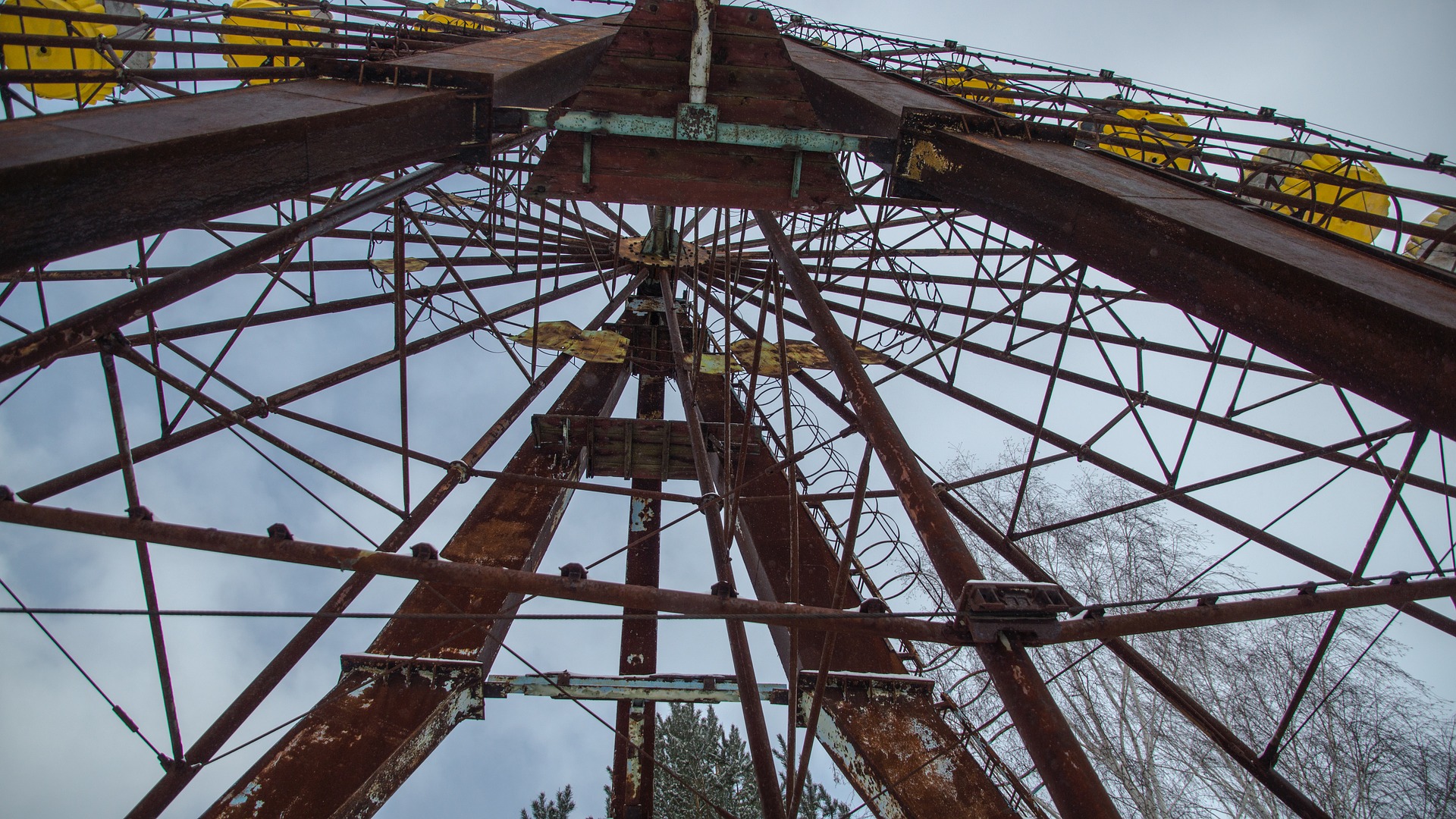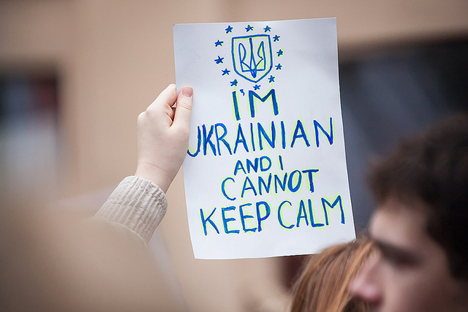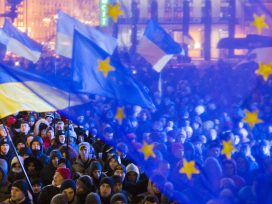Riding the rollercoaster
Since Ukraine’s referendum for independence in 1991, the country has seen its fair share of ups and downs. Over the past thirty years, Ukraine artists have been exploring issues of identity amongst the ruins of utopia yet have only recently gained recognition.
In the thirty or so years since the collapse of the USSR, Ukraine has gained independence, witnessed unprecedented growth in oligarchical capitalism and corruption, and lived through three waves of mass protests, two revolutions, a hybrid war in the East of the country, the annexation of Crimea, and an overdue and overwrought process of decommunization. At the same time, Ukrainian politics has descended into pure carnival. Flashes of direct political action are routinely followed by long periods of drawn-out political theatre; the movement between these two modes characterizes this period. A permanent state of social turbulence has gradually become habit and this, in turn, has helped shape several generations of Ukrainian artists whose worldview is inextricably linked with life during times of radical change.

Pripyat amusement park. Photo by Följ from Pixabay
To this day, Ukraine is still seen by some foreigners as a small replica of Russia. The reality, however, is that Ukraine has a radically different culture and political context with its own particular history. Perhaps it is because Ukraine isn’t sufficiently exotic that its ‘otherness’ gets little attention and the country sits at the fringes of pan-European discourse. Despite its immensity, varied history, and rich cultural tradition that has been heavily influenced by the country’s artists, Ukraine remains a blind spot for the rest of Europe.
In 1850, Karl Marx wrote about permanent revolution and how the final goal of all revolutionary transformations was to transition to a classless society while bringing radical change to society’s ideas and attitudes. In the 20th century, Leon Trotsky took Marx’s words and reformulated them. As they sang in a famous Soviet song, “A revolution has a beginning, but it has no end.”1 In the case of modern-day Ukraine, the state of permanent revolution is a fitting metaphor for the atmosphere in the country. Ukraine has been riding the rollercoaster of social upheaval for three decades as mass protests have followed one after the other, all while the tragic spectre of 1917 hovers silently overhead. Where the Western intellectual’s fantasy about revolution ends is where the reality of Ukraine’s recent history begins, and that reality exists in sharp contrast to any theory.
The country’s artistic energy and atmosphere have evolved thanks to a combination of factors: the state of turbulence, which once begun doesn’t seem to have an end; the country’s painful search for identity within a theatre of shadows from the past; the fact of living amidst the ruins of the greatest utopia of the 20th century; and the sincere belief that, despite a multitude of historical scars, society can, and should, change.

Euromaidan, 1 December 2013. Photo: Alexandra (Nessa) Gnatoush. Source: Flickr
There is another unexpected aspect to the metaphor of permanent revolution in modern-day Ukraine, which is in the spirit of Marx’s original theory about the export and sharing of ideas. In recent years there has been an interesting development: following perestroika and the collapse of the USSR in Ukraine, as in other former Soviet republics, it was commonly thought that a time would come when the country would overcome the remnants of its totalitarian past and become a Western-style democracy. Paradoxically, however, everything is happening the other way around. It appears now that Western countries are beginning to experience things that have long been familiar in Ukraine. Indeed, any Westerners familiar with the history of post-Soviet Ukraine would be forgiven for having slight déjà vu. There are oligarchs in power and trophy wives, hybrid wars and colour revolutions, the hollowing out of familiar narratives, relativism, and a total loss of trust. Following the 2016 US elections, the whole world began to talk about the ‘post-truth’ age and information manipulation on the internet, yet it was during the 2013–2014 EuroMaidan protests that Ukraine became one of the first targets of a huge disinformation campaign with social networking sites flooded with fake news.
The global changes brought about by the arrival of digital capitalism have introduced deep confusion, a sense of bewilderment for the future, and the need to fundamentally rethink previous models of social order. Since the collapse of the USSR, Ukraine has learned to survive atop the ruins of old values and ways of thinking. At the same time, the country has managed not to fall back into the clutches of authoritarianism. In a sense, over the past three decades, Ukrainian society has already lived through many of the challenges of modernity that the rest of the world is only now beginning to encounter.
What place is there for modern art in a worldview which is almost entirely subordinate to the eros of politics? What is political art in an environment where the very word politics has become synonymous with corruption and lawlessness? At the same time, what does it mean in a place where the country’s main square is regularly graced with barricades whose beauty and elemental conceptualism the world’s best artists could only dream of?
A surprising paradox exists in Ukraine today: while the art scene has developed rapidly, there are still very few comprehensive texts that cover the history of the different movements and phenomena that make up Ukrainian modern art. The blame for this lies, first and foremost, with the systemic and institutional crisis that exists in the country, a crisis which, 28 years after Ukraine achieved independence, has still not been overcome. Constant societal transformation does little to strengthen the function of memory. The individual’s inner voice, founded on the experience of past generations who have survived ‘the short 20th century’ (which the historian Eric Hobsbawm called the ‘age of extremes’), constantly whispers to us that some things are easier to just forget. Thus, we find ourselves in a situation where the biggest risk to our art — and society in general — is our memory ceasing to work.
Once Ukraine regained independence, modern art gradually became the dominant artistic paradigm in the country. How are we to understand this phenomenon and how does it relate to art from the Soviet period, the nonconformist tradition, and the avant-garde movements of the early 20th century? Since 1991, not enough work has been done to set up a comprehensive archive or conduct an analysis of the entire cultural period. State museum foundations haven’t put in place any kind of comprehensive procurement strategy, and the Ukrainian Museum of Modern Art remains a utopian dream. Thankfully, in recent years the situation has begun to improve. It seems that many have suddenly remembered how interesting it can be to write and publish books.
This text, republished in collaboration with the Institute for Human Sciences, Vienna, comes from the book Permanent Revolution by Alisa Lozhkina.
Leon Trotsky, Permanentnaia revolutsiia (Berlin: Granit, 1930). For Trotsky, the key to victory for socialism in the USSR was the export of revolution to the West and the ensuing victory of communism on a global scale. In this work, ‘permanent revolution’ is meant in a metaphorical sense.
Published 1 December 2021
Original in Ukrainian
Translated by
Nathan Jeffers
First published by ArtHuss 2020
Contributed by The Institute for Human Sciences (IWM) © Alisa Lozhkina / ArtHuss / The Institute for Human Sciences (IWM) / Eurozine
PDF/PRINTIn collaboration with
In focal points
- Not epistemic enough to be discussed
- Another lost generation of art?
- A trace of Russia at the heart of Austria
- What makes a humanist kill?
- Something happens, somewhere
- Vertical occupation
- No longer a footnote
- The Ides of March
- Counteroffensive exhibitions
- No peace without freedom, no justice without law
Newsletter
Subscribe to know what’s worth thinking about.



